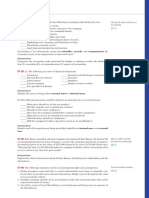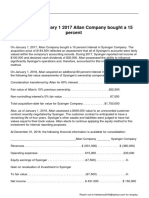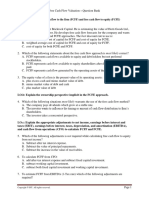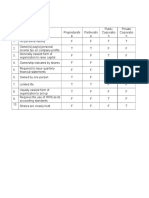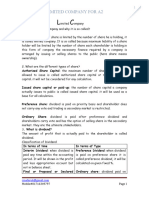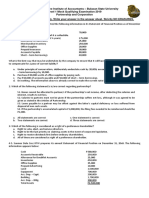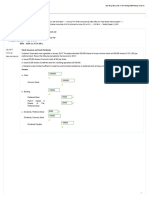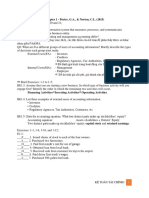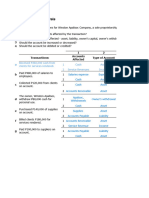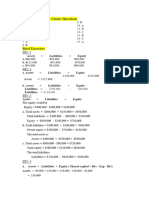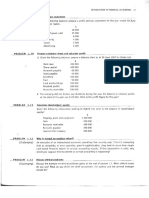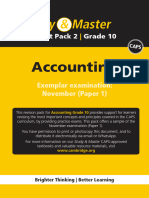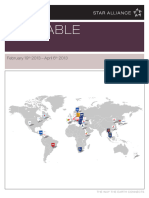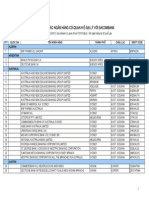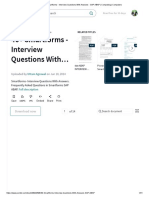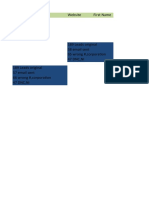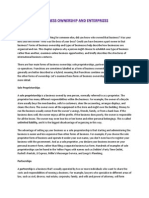Solutions To Recommended Questions - Chapter 1
Solutions To Recommended Questions - Chapter 1
Uploaded by
David Terran TangCopyright:
Available Formats
Solutions To Recommended Questions - Chapter 1
Solutions To Recommended Questions - Chapter 1
Uploaded by
David Terran TangOriginal Title
Copyright
Available Formats
Share this document
Did you find this document useful?
Is this content inappropriate?
Copyright:
Available Formats
Solutions To Recommended Questions - Chapter 1
Solutions To Recommended Questions - Chapter 1
Uploaded by
David Terran TangCopyright:
Available Formats
Chapter 1 Recommended Questions
PROBLEM 1-1A
(a) 1. The South Face Inc. is an external user of accounting information in assessing
the creditworthiness of their customer.
2. An investor purchasing common shares of Orbite Online Inc. is an external user.
3. In deciding whether to extend a loan, Caisse d’Économie Base Montréal is an
external user.
4. As an employee of Tech Toy Limited, the CFO is an internal user.
(b) 1. In deciding to extend credit, South Face would focus its attention on the
statement of financial position of the new customer. The terms of credit they
are extending require repayment in a short period of time. Funds to repay the
credit would come from cash on hand and other current assets. The statement
of financial position of the new customer will show if the company has enough
current assets to meet its current obligations.
2. Since the investor intends to hold the shares for a long period of time (at least
five years), s(he) should focus on the company’s income statement. The income
statement reports the company’s past performance in terms of revenues,
expenses, and net income. This is generally regarded as a good indicator of the
company’s future performance.
3. The Caisse is interested in two things—the ability of the company to make
interest payments on a monthly basis for the next three years and the ability to
repay the principal amount at the end of the three years. In order to evaluate
both of these factors, the focus should be on the statement of cash flows. This
statement provides information on the cash the company generates from its
operations on an ongoing basis. It also tells whether the company is currently
borrowing or repaying debt.
4. The CFO should focus on the statement of cash flows as this statement clearly
sets out the cash generated from operating activities and the amount the
company has spent in the past on purchasing equipment and paying dividends.
Note: Other answers may be valid provided they are properly supported.
Copyright © 2017 John Wiley & Sons Canada, Ltd. Page 1 of 16
Chapter 1 Recommended Questions
PROBLEM 1-2A
(a) 1. The professors should incorporate their business as a private corporation
because of their concerns about legal liabilities. A corporation is the only form
of business that provides limited liability. Since the professors do not need
access to large amounts of investment capital, a private corporation provides
the limited liability advantage the professors need.
2. Joseph should run his bicycle rental shop as a proprietorship because this is the
simplest and least costly form of business organization to establish and
eventually dissolve. He is the only person involved in the business and is
planning to operate for a limited time.
3. The size of the businesses is not given, but Robert and Tom should likely form
a public corporation, if possible, when they combine their operations. This is
the best form of business for them to choose because they expect to raise funds
in the coming year. A public corporation will enable them to raise significant
amounts of funds for their manufacturing company. A corporation may also
receive more favourable income tax treatment. If they are not large businesses,
then Robert and Tom may choose to form a private corporation.
4. A partnership would be the most likely form of business for Darcy, Ellen, and
Meg to choose. It is simpler to form than a corporation and less costly.
5. Hervé is most likely to select to operate his business as a private corporation.
This will assist him with the liability of storing goods for others. He will also
be able to raise funds to purchase equipment, rent space in airports, and hire
employees. It is easier to raise funds through a private corporation rather than
a proprietorship or partnership.
(b) 1. ASPE
2. ASPE
3. IFRS
4. ASPE
5. ASPE
Copyright © 2017 John Wiley & Sons Canada, Ltd. Page 2 of 16
Chapter 1 Recommended Questions
PROBLEM 1-4A
(a) (b)
Accounts payable L SFP
Accounts receivable A SFP
Bank indebtedness L SFP
Bank loan payable L SFP
Cash A SFP
Common shares SC SFP, SCE
Equipment A SFP
Goodwill A SFP
Income tax expense E IS
Income tax payable L SFP
Interest expense E IS
Office expense E IS
Prepaid insurance A SFP
Rent expense E IS
Repair and maintenance expense E IS
Salaries payable L SFP
Service revenue R IS
Supplies A SFP
Vehicles A SFP
Note:
• instead of using SFP (statement of financial position) you could state BS
(Balance Sheet)
• The textbook states “supplies” as a balance sheet account. You will be given
supplies inventory or supplies expense to ensure you will know which account to
refer to
Copyright © 2017 John Wiley & Sons Canada, Ltd. Page 3 of 16
Chapter 1 Recommended Questions
PROBLEM 1-5A
(a) and (b)
(b)
Shareholders’
(a) Assets Liabilities Equity
Accounts payable $15,600 L $ 15,600
Accounts receivable 13,100 A $13,100
Bank loan payable 32,000 L 32,000
Cash 9,350 A 9,350
Common shares 20,000 SE $ 20,000
Equipment 30,500 A 30,500
Income tax payable 1,800 L 1,800
Intangible assets 5,000 A 5,000
Interest payable 300 L 300
Inventory 9,200 A 9,200
Prepaid insurance 1,000 A 1,000
Retained earnings 21,250 SE 21,250
Salaries payable 700 L 700
Supplies 2,800 A 2,800
Unearned revenue 1,800 L 1,800
Vehicles 22,500 A 22,500 ______ ______
Totals $93,450 $52,200 $41,250
Assets = Liabilities + SE
$93,450 = $52,200 + $41,250
Note: The textbook states “supplies” as a balance sheet account. You will be given
supplies inventory or supplies expense to ensure you will know which account to refer to
(c) Beginning balance in Retained Earnings + Revenues – Expenses – Dividends
declared = Ending balance in Retained Earnings
$18,000 + $296,750 – $278,500 – $15,000 = $21,250
Copyright © 2017 John Wiley & Sons Canada, Ltd. Page 4 of 16
Chapter 1 Recommended Questions
PROBLEM 1-7A
(a)
ONE PLANET COSMETICS CORP.
Income Statement
Month Ended June 30, 2018
Revenues
Service revenue $24,200
Expenses
Salaries expense $5,700
Office expense 1,500
Utilities expense 1,500
Supplies expense 2,100
Interest expense 800
Total expenses 11,600
Income before income tax 12,600
Income tax expense 700
Net income $11,900
[Revenues – Expenses = Net income or (loss)]
ONE PLANET COSMETICS CORP.
Statement of Changes in Equity
Month Ended June 30, 2018
Common Retained Total
Shares Earnings Equity
Balance, June 1 $ 0 $ 0 $ 0
Issued common shares 36,000 36,000
Net income 11,900 11,900
Dividends declared (1,000) (1,000)
Balance, June 30 $36,000 $10,900 $46,900
(Beginning equity ± Changes to equity = Ending equity)
Copyright © 2017 John Wiley & Sons Canada, Ltd. Page 5 of 16
Chapter 1 Recommended Questions
PROBLEM 1-7A (CONTINUED)
(a) (continued)
Note: Students may list the accounts in the following statement in any order within
the assets, liabilities, and shareholders’ equity classifications as they have not yet
learned how to classify/order accounts.
ONE PLANET COSMETICS CORP.
Statement of Financial Position
June 30, 2018
Assets
Cash $ 15,000
Accounts receivable 9,000
Supplies 1,200
Equipment 52,000
Total assets $77,200
Liabilities and Shareholders’ Equity
Liabilities
Accounts payable $ 7,300
Bank loan payable 23,000
Total liabilities 30,300
Shareholders’ equity
Common shares 36,000
Retained earnings 0 10,900
Total shareholders’ equity 46,900
Total liabilities and shareholders’ equity $77,200
(Assets – Liabilities = Shareholders’ equity)
(b) The financial statements must be prepared in the order of (1) income statement,
(2) statement of changes in equity, and (3) statement of financial position. This is
because each subsequent financial statement depends on information contained in
the previous statement. The net income from the income statement flows to the
retained earnings account on the statement of changes in equity. The shareholders’
equity totals in the statement of changes in equity (for example, for common shares
and retained earnings) then flow to the shareholders’ equity section of the
statement of financial position.
Copyright © 2017 John Wiley & Sons Canada, Ltd. Page 6 of 16
Chapter 1 Recommended Questions
PROBLEM 1-9A
(a)
[1] Operating expenses = Service revenue – Income before income tax
Operating expenses = $225,000 – $45,000
Operating expenses = $180,000
[2] Net income = Income before income tax – Income tax expense
Net income = $45,000 – $9,000
Net income = $36,000
[3] Net income (from [2]) = $36,000
[4] Ending retained earnings = Beginning retained earnings + Net income –
Dividends declared
Ending retained earnings = $0 + $36,000 (from [2]) – $15,000
Ending retained earnings = $21,000
[5] Total issued common shares = $250,000
[6] Net income = $36,000 (from [3])
[7] Total equity = Beginning balance + Issued common shares + Net income –
Dividends declared
Total equity = $0 + $250,000 (from [5]) + $36,000 (from [6]) – $15,000
Total equity = $271,000
[8] Land = Total assets (from [9]) – Cash – Accounts receivable –
Building – Equipment
Land = $964,000 – $22,000 – $34,000 – $390,000 – $218,000
Land = $300,000
[9] Total assets = Total liabilities + Shareholders' equity
Total Assets = $964,000
[10] Accounts payable = Total liabilities – Bank loan payable
Accounts payable = $693,000 – $600,000
Accounts payable = $93,000
Copyright © 2017 John Wiley & Sons Canada, Ltd. Page 7 of 16
Chapter 1 Recommended Questions
PROBLEM 1-9A (CONTINUED)
[11] Common shares = $250,000 (from the Statement of Changes in Equity)
[12] Retained earnings = $21,000 (from [4])
[13] Total shareholders' equity = Common shares + Retained earnings
Total shareholders' equity = $250,000 (from [11]) + $21,000 (from [12])
= $271,000 or (from [7])
(b) (1) In preparing the financial statements, the first statement to be prepared is the
income statement, followed by the statement of changes in equity, and then
the statement of financial position.
Note to instructors: While the statements must be prepared in this sequence,
these statements can be presented in a variety of orders. Often the statement
of financial position is presented first, as the most “permanent” statement.
(2) The reason the statements must be prepared in the order indicated above is
that each statement depends on information in the previously prepared
statement. For example, the net income figure from the income statement is
used in the statement of changes in equity to calculate the ending balance of
retained earnings. The shareholders’ equity section of the statement of
financial position is then completed using the ending balances of common
shares and retained earnings, as calculated in the statement of changes in
equity.
Copyright © 2017 John Wiley & Sons Canada, Ltd. Page 8 of 16
Chapter 1 Recommended Questions
PROBLEM 1-1B
(a) 1. An investor purchasing common shares of Fight Fat Ltd. is an external user.
2. As a potential creditor, Comeau Ltée is an external user.
3. The chief financial officer is an internal user.
4. As a potential creditor, Drummond Bank is an external user.
(b) 1. In making an investment in common shares, the Ontario investor is becoming a
partial owner (shareholder) of the company. In this case, the investment will be
held for at least three years. The information that will be most relevant to
him/her will be on the income statement. The income statement reports the past
performance of the company in terms of its revenue, expenses, and net income.
This is the best indicator of the company’s future potential.
2. In deciding to extend credit to a new customer, Comeau would focus its
attention on the new customer's statement of financial position. The terms of
credit they are extending require repayment in a short period of time. Funds to
repay the credit would come from current assets. The statement of financial
position of the new customer will show whether the company has enough
current assets to meet its current obligations.
3. In order to determine whether the company is generating enough cash to
increase the amount of dividends paid to investors, the CFO of Private Label
needs information on the amount of cash generated and used in various
activities of the business. The statement of cash flows is the most useful
statement for this purpose. This statement presents the amount of cash at the
beginning and end of the period as well as the details of the amount of cash
generated by operating activities and the amount spent on expanding operations
(investing activities).
4. In deciding whether to extend a loan, Drummond Bank is interested in two
things: the ability of the company to make its monthly interest payments for the
next five years and the ability to repay the principal amount at the end of five
years. In order to evaluate both of these factors the focus should be on the
statement of cash flows. This statement provides information on the cash the
company generates from its operating activities on an ongoing basis. This will
be the most important factor in determining if the company will survive and be
able to repay the principal and interest on the loan.
Note : Other answers may be valid provided they are properly supported.
Copyright © 2017 John Wiley & Sons Canada, Ltd. Page 9 of 16
Chapter 1 Recommended Questions
PROBLEM 1-2B
(a) 1. Dawn will likely operate her vegetable stand as a proprietorship because she is
planning on operating it for a short time period. A proprietorship is the simplest
and least costly business organization to form and dissolve.
2. Joseph and Sabra should form a private corporation when they combine their
operations. A private corporation will be easier and less expensive to form than
a public corporation. It will also be an easier type of organization in which to
raise funds than a proprietorship or partnership. A corporation may also receive
more favourable income tax treatment.
3. The professors should incorporate their business as a private corporation because
of their concerns about the legal liabilities. A corporation is the only form of
business that provides limited liability to its owners.
4. Abdul would likely form a public corporation because he needs to raise funds to
invest in inventories and property, plant, and equipment. He has no savings or
personal assets and it is normally easier to raise funds through a corporation than
through a proprietorship or partnership. A public corporation will allow Abdul
to raise larger amounts of funds by selling shares to the public.
5. A partnership would be the most likely form of business for Mary, Richard, and
Jigme to choose. It is simpler to form than a corporation and less costly.
(b) 1. ASPE
2. ASPE
3. ASPE
4. IFRS
5. ASPE
Copyright © 2017 John Wiley & Sons Canada, Ltd. Page 10 of 16
Chapter 1 Recommended Questions
PROBLEM 1-4B
(a) (b)
Accounts payable L SFP
Accounts receivable A SFP
Bank loan payable L SFP
Buildings A SFP
Cash A SFP
Common shares SE SFP, SCE
Cost of goods sold E IS
Equipment A SFP
Income tax expense E IS
Income tax payable L SFP
Intangible assets A SFP
Interest expense E IS
Land A SFP
Merchandise inventory A SFP
Mortgage payable L SFP
Office expense E IS
Prepaid insurance A SFP
Retained earnings SE SFP, SCE
Salaries payable L SFP
Sales R IS
Unearned revenue L SFP
Note: instead of using SFP (statement of financial position) you could state BS (Balance
Sheet)
Copyright © 2017 John Wiley & Sons Canada, Ltd. Page 11 of 16
Chapter 1 Recommended Questions
PROBLEM 1-5B
(a) and (b)
(b)
Shareholders’
(a) Assets Liabilities Equity
Accounts payable $23,100 L $23,100
Accounts receivable 6,950 A $ 6,950
Bank loan payable 25,000 L 25,000
Cash 17,750 A 17,750
Common shares 20,000 SE $ 20,000
Equipment 66,200 A 66,200
Income tax payable 1,900 L 1,900
Interest payable 500 L 500
Inventory 21,300 A 21,300
Prepaid insurance 950 A 950
Retained earnings 39,850 SE 39,850
Salaries payable 3,050 L 3,050
Supplies 3,750 A 3,750
Unearned revenue 3,500 L _______ 3,500 _______
Totals $116,900 $57,050 $59,850
Assets = Liabilities + Shareholders’ equity
$116,900 = $57,050 + $59,850
(c) Beginning balance in Retained Earnings + Revenues – Expenses – Dividends
Declared = Ending balance in Retained Earnings
$8,850 + $365,000 – $333,000 – $1,000 = $39,850
Copyright © 2017 John Wiley & Sons Canada, Ltd. Page 12 of 16
Chapter 1 Recommended Questions
PROBLEM 1-7B
(a) AERO FLYING SCHOOL LTD.
Income Statement
Month Ended May 31, 2018
Revenues
Service revenue $215,300
Expenses
Fuel expense $85,400
Rent expense 12,100
Office expense 12,700
Salaries expense 36,600
Repair and maintenance expense 40,900
Interest expense 12,500 200,200
Income before income tax 15,100
Income tax expense 2,800
Net income $ 12,300
[Revenues – Expenses = Net income or (loss)]
AERO FLYING SCHOOL LTD.
Statement of Changes in Equity
Month Ended May 31, 2018
Common Retained Total
Shares Earnings Equity
Balance, May 1 $ 0 $ 0 $ 0
Issued common shares 180,000 180,000
Net income 12,300 12,300
Dividends declared (2,700) (2,700)
Balance, May 31 $180,000 $9,600 $189,600
(Beginning equity ± Changes to equity = Ending equity)
Copyright © 2017 John Wiley & Sons Canada, Ltd. Page 13 of 16
Chapter 1 Recommended Questions
PROBLEM 1-7B (CONTINUED)
(a) (continued)
Note: Students may list the accounts in the following statement in any order within
the assets, liabilities, and shareholders’ equity classifications as they have not yet
learned how to classify/order accounts.
AERO FLYING SCHOOL LTD.
Statement of Financial Position
May 31, 2018
Assets
Cash $ 26,900
Accounts receivable 22,600
Supplies 15,000
Equipment 372,500
Total assets $ 437,000
Liabilities and Shareholders’ Equity
Liabilities
Accounts payable $ 6,400
Bank loan payable 241,000
Total liabilities 247,400
Shareholders’ equity
Common shares 180,000
Retained earnings 9,600
Total shareholders’ equity 189,600
Total liabilities and shareholders’ equity $437,000
(Assets – Liabilities = Shareholders’ equity)
(b) The financial statements must be prepared in the order of (1) income statement,
(2) statement of changes in equity, and (3) statement of financial position. This is
because each subsequent financial statement depends on information contained in
the previous statement. The net income from the income statement flows to the
retained earnings in the statement of changes in equity. The shareholders’ equity
totals (for example, for common shares and retained earnings) in the statement of
changes in equity then flow to the shareholders’ equity section of the statement of
financial position.
Copyright © 2017 John Wiley & Sons Canada, Ltd. Page 14 of 16
Chapter 1 Recommended Questions
PROBLEM 1-9B
(a) [1] Operating expenses = Service revenue – Income before income tax
Operating expenses = $325,000 – $116,000
Operating expenses = $209,000
[2] Net income = Income before income tax – Income tax expense
Net income = $116,000 – $23,000
Net income = $93,000
[3] Net income = $93,000 (same as [2])
[4] Dividends declared = Beginning retained earnings + Net income –
Ending retained earnings
Dividends declared = $440,000 + $93,000 – $521,000
Dividends declared = $12,000
[5] Beginning total equity = Beginning common shares + Beginning
retained earnings
Beginning total equity = $250,000 + $440,000
Beginning total equity = $690,000
[6] Total common shares issued = $60,000
[7] Net income = $93,000 (same as [3])
[8] Dividends declared = $12,000 (same as [4])
[9] Ending total equity = Ending common shares + Ending retained earnings
Ending total equity = $310,000 + $521,000
Ending total equity = $831,000
[10] Cash = Total assets – (Accounts receivable + Land + Buildings + Equipment)
Cash = $1,351,000 (from [11]) – ($34,000 + $310,000 + $616,000
+ $364,000)
Cash = $27,000
Copyright © 2017 John Wiley & Sons Canada, Ltd. Page 15 of 16
Chapter 1 Recommended Questions
PROBLEM 1-9B (CONTINUED)
[11] Total assets = Total liabilities and shareholders’ equity
Total assets = $1,351,000
[12] Common shares = $310,000 (as per statement of changes in equity)
[13] Retained earnings = $521,000 (as per statement of changes in equity)
(b) (1) In preparing the financial statements, the first statement to be prepared is the
income statement, followed by the statement of changes in equity, and then
the statement of financial position. While the statements must be prepared in
this sequence, these statements can be presented in a variety of orders. Often
the statement of financial position is presented first, as the most “permanent”
statement.
(2) The reason the statements must be prepared in the order indicated above is
that each statement depends on information in the previously prepared
statement. For example, the net income figure in the income statement is
used in the statement of changes in equity to calculate the ending balance of
retained earnings. The shareholders’ equity section of the statement of
financial position is then completed using the ending balances of the
shareholders’ equity components (such as common shares and retained
earnings) as calculated in the statement of changes in equity.
Copyright © 2017 John Wiley & Sons Canada, Ltd. Page 16 of 16
You might also like
- Map of Nigeria Oil FieldDocument1 pageMap of Nigeria Oil Fieldriddi12355% (11)
- CH 01Document4 pagesCH 01Rabie Haroun50% (2)
- BFSI Company DetailsDocument48 pagesBFSI Company DetailsSudipto Chatterjee0% (1)
- Entrepreneurship-1112 Q2 SLM WK7Document8 pagesEntrepreneurship-1112 Q2 SLM WK7April Jean Cahoy56% (9)
- Corporate Financial Distress, Restructuring, and Bankruptcy: Analyze Leveraged Finance, Distressed Debt, and BankruptcyFrom EverandCorporate Financial Distress, Restructuring, and Bankruptcy: Analyze Leveraged Finance, Distressed Debt, and BankruptcyNo ratings yet
- On January 1 2017 Allan Company Bought A 15 PercentDocument2 pagesOn January 1 2017 Allan Company Bought A 15 PercentAmit PandeyNo ratings yet
- Sending Text Messages Through EmailDocument63 pagesSending Text Messages Through Emailswilliams5182No ratings yet
- The Gone Fishin' Portfolio: Get Wise, Get Wealthy...and Get on With Your LifeFrom EverandThe Gone Fishin' Portfolio: Get Wise, Get Wealthy...and Get on With Your LifeNo ratings yet
- Summary of William H. Pike & Patrick C. Gregory's Why Stocks Go Up and DownFrom EverandSummary of William H. Pike & Patrick C. Gregory's Why Stocks Go Up and DownNo ratings yet
- R31 Free Cash Flow Valuation Q Bank PDFDocument8 pagesR31 Free Cash Flow Valuation Q Bank PDFZidane Khan100% (1)
- Chapter 1 To 8 Practice Problem SolutionsDocument120 pagesChapter 1 To 8 Practice Problem SolutionsHardeep Kaur100% (1)
- Assignment 1: AP1-5A CL SI CL NCA CA SI SCF SI SC CA NCLDocument10 pagesAssignment 1: AP1-5A CL SI CL NCA CA SI SCF SI SC CA NCLAsad MahmoodNo ratings yet
- Solutions Manual: Accounting: Building Business SkillsDocument31 pagesSolutions Manual: Accounting: Building Business SkillsNicole HungNo ratings yet
- MGMT 600 SAMPLE Midterm Exam 1Document9 pagesMGMT 600 SAMPLE Midterm Exam 1Enkhbadral UlaanhuuNo ratings yet
- Partnerships - Formation, Operations, and Changes in Ownership InterestsDocument12 pagesPartnerships - Formation, Operations, and Changes in Ownership InterestsJEFFERSON CUTENo ratings yet
- Acc 1 QuizDocument7 pagesAcc 1 QuizAyat MukahalNo ratings yet
- Limited Company Format A2 (Repaired)Document7 pagesLimited Company Format A2 (Repaired)Sterling ArcherNo ratings yet
- ABM FABM 2 Q1 ModuleDocument56 pagesABM FABM 2 Q1 Modulejeromemallorca10No ratings yet
- 3 ACCT 2AB P. DissolutionDocument6 pages3 ACCT 2AB P. DissolutionMary Angeline LopezNo ratings yet
- Topic 10 - Practice ProblemsDocument2 pagesTopic 10 - Practice ProblemsAnna Mariyaahh DeblosanNo ratings yet
- Mergers, Acquisitions, and RestructuringDocument21 pagesMergers, Acquisitions, and Restructuringmukesh0887No ratings yet
- Of The Account Would Be Recorded.: Instructions. Identify The Manner in Which The Each of The Increases or DecreasesDocument5 pagesOf The Account Would Be Recorded.: Instructions. Identify The Manner in Which The Each of The Increases or DecreasesLoriNo ratings yet
- Module 2Document6 pagesModule 2Mary Joy CabilNo ratings yet
- Module 2Document6 pagesModule 2trixie mae0% (1)
- Test08 Chapter11 CC01Document4 pagesTest08 Chapter11 CC01vinh.thuy1134No ratings yet
- CAPE Accounting 2017 U1 P2 PDFDocument11 pagesCAPE Accounting 2017 U1 P2 PDFmama12222No ratings yet
- Chapter 1 - PartiiiDocument24 pagesChapter 1 - PartiiiYE MIN AUNGNo ratings yet
- Chapter 5Document6 pagesChapter 5Minh HuyyNo ratings yet
- Financial Analysis and Reporting - Midterm ExamDocument4 pagesFinancial Analysis and Reporting - Midterm ExamElla Marie LopezNo ratings yet
- Assignment No. 1 (Financial Transactions) Answer KeyDocument9 pagesAssignment No. 1 (Financial Transactions) Answer KeyHeasylyn tadeoNo ratings yet
- AFARS14 General ReviewDocument15 pagesAFARS14 General ReviewBeatrice Teh100% (4)
- Workbook CH 6Document72 pagesWorkbook CH 6grayNo ratings yet
- Transactions Activity Cash Effect: CO CO CO NE CO CI NE CO NE CI CO NE CI CO CIDocument2 pagesTransactions Activity Cash Effect: CO CO CO NE CO CI NE CO NE CI CO NE CI CO CIMasTer PanDaNo ratings yet
- Accounting Problem BookDocument97 pagesAccounting Problem Bookliza.thereNo ratings yet
- Bài tập C1Document12 pagesBài tập C1Khanh LêNo ratings yet
- SOLUTIONS TO Ch.5Document56 pagesSOLUTIONS TO Ch.5chemka6006No ratings yet
- Reviewer TransactionDocument7 pagesReviewer TransactionRamos JovelNo ratings yet
- 3054 Faca-V L 8Document8 pages3054 Faca-V L 8ab6154951No ratings yet
- Statement of Financial Position (SFP) : TNHS Main - SHS - Accountancy, Business and ManagementDocument10 pagesStatement of Financial Position (SFP) : TNHS Main - SHS - Accountancy, Business and ManagementPedana RañolaNo ratings yet
- Exercises Set B 1 Exercises Set B CompressDocument7 pagesExercises Set B 1 Exercises Set B CompressHoèn Hoèn100% (1)
- Case Study 1Document5 pagesCase Study 18142301001No ratings yet
- Afar 02: Corporate Liquidation: I. True or False - Theory of AccountsDocument5 pagesAfar 02: Corporate Liquidation: I. True or False - Theory of AccountsRoxell CaibogNo ratings yet
- Error Correction: Date of Loan Amount Maturity Date Term of LoanDocument4 pagesError Correction: Date of Loan Amount Maturity Date Term of LoanElaineCopino100% (1)
- ACCT10002 Tutorial 1 Exercises, 2020 SM1Document5 pagesACCT10002 Tutorial 1 Exercises, 2020 SM1JING NIENo ratings yet
- ch11 SM Carlon 5eDocument67 pagesch11 SM Carlon 5eKyle100% (1)
- FA - Pre Foundation Phase - Sample PaperDocument5 pagesFA - Pre Foundation Phase - Sample PaperJaved MohammedNo ratings yet
- Corporate Accounting IIDocument5 pagesCorporate Accounting II2vj77sn8x5No ratings yet
- Chapter 5Document25 pagesChapter 5Tanzeel HussainNo ratings yet
- Week 1 Topic Tutorial Solutions CB2100 - 1920ADocument6 pagesWeek 1 Topic Tutorial Solutions CB2100 - 1920ALily TsengNo ratings yet
- 12CEAccounts SolutionDocument9 pages12CEAccounts SolutionMihir ThakkarNo ratings yet
- Basic Accounting IDocument24 pagesBasic Accounting IAlpha HoNo ratings yet
- Quiz1BASFIN1_SolutionK31Document8 pagesQuiz1BASFIN1_SolutionK31Richmond Esperidion (Sperrydion)No ratings yet
- Accounts Home Test 2Document7 pagesAccounts Home Test 2Ashish RaiNo ratings yet
- L03 - Accounting Classification and EquationsDocument29 pagesL03 - Accounting Classification and EquationsmardhiahNo ratings yet
- 2.2. Ind AS 7Document25 pages2.2. Ind AS 7Ajay JangirNo ratings yet
- Bac Elims: Effortless RoundDocument3 pagesBac Elims: Effortless RoundTracy Miranda BognotNo ratings yet
- Act201 AssignmentDocument4 pagesAct201 Assignmentmahmud100% (1)
- 5 Financial Statements of CompaniesDocument11 pages5 Financial Statements of Companiessunil.h68 SunilNo ratings yet
- PA Lecture 7Document15 pagesPA Lecture 7jackparker01321No ratings yet
- Chap 01 Case SoftbyteDocument5 pagesChap 01 Case SoftbytevdyrnwtoylafeavqutNo ratings yet
- GR10 Accounting Practice Exam November Paper 1Document7 pagesGR10 Accounting Practice Exam November Paper 1chantelsiphokazi730No ratings yet
- Equity Valuation: Models from Leading Investment BanksFrom EverandEquity Valuation: Models from Leading Investment BanksJan ViebigNo ratings yet
- How to Read a Financial Report: Wringing Vital Signs Out of the NumbersFrom EverandHow to Read a Financial Report: Wringing Vital Signs Out of the NumbersNo ratings yet
- Star Alliance 2013Document564 pagesStar Alliance 2013yoshifunky93No ratings yet
- Memorandum Articles of Association Under Companies Act2013Document6 pagesMemorandum Articles of Association Under Companies Act2013Raj AnkitNo ratings yet
- Unit 7 Lo1Document3 pagesUnit 7 Lo1api-236306935No ratings yet
- DS NHDL 311213Document29 pagesDS NHDL 311213Khiem NguyenNo ratings yet
- Extractdocument 20231010Document11 pagesExtractdocument 20231010je94540No ratings yet
- Akta SyarikatDocument50 pagesAkta SyarikatKamsul DiksiNo ratings yet
- Standard Ceramic Dividend PolicyDocument23 pagesStandard Ceramic Dividend PolicyEmon HossainNo ratings yet
- Jitendra Mohananey B. Com., LL.B., ACA, ACS +91 9810287311Document35 pagesJitendra Mohananey B. Com., LL.B., ACA, ACS +91 9810287311rahulmohiniNo ratings yet
- Prodname Qty AmountDocument8 pagesProdname Qty AmountPawan ShahiNo ratings yet
- Chapter 13 Investment in AssociatesDocument17 pagesChapter 13 Investment in Associatesmichelle0% (1)
- Sole Proprietor and PartnershipDocument18 pagesSole Proprietor and PartnershipMaks Bravezsoul100% (1)
- Key Players of Enron ScandalDocument1 pageKey Players of Enron ScandalafzalkhanNo ratings yet
- Kolkatta 5Document38 pagesKolkatta 5amitmulikNo ratings yet
- DoorDash Revenue and Usage Statistics (2021) - Business of AppsDocument6 pagesDoorDash Revenue and Usage Statistics (2021) - Business of AppsMarcos Moreira AlvesNo ratings yet
- Company Memorandum Packet 4Document4 pagesCompany Memorandum Packet 4Zul Aizat HamdanNo ratings yet
- Chapter 17 - Investment in Associate PDFDocument14 pagesChapter 17 - Investment in Associate PDFTurks100% (1)
- Annual - Return - For - Financial - Year - 2017 - 2018 Icici SecuritiesDocument21 pagesAnnual - Return - For - Financial - Year - 2017 - 2018 Icici Securitiesprayas sarkarNo ratings yet
- 40+ Smartforms - Interview Questions With Answers - SAP ABAP - Computing - ComputersDocument31 pages40+ Smartforms - Interview Questions With Answers - SAP ABAP - Computing - ComputersMadhuri ReddyNo ratings yet
- Daftar Pustaka: Anwar MaulanaDocument4 pagesDaftar Pustaka: Anwar MaulanasatriawahyuNo ratings yet
- Allahabad Bank: Prepared By: Saumil ShahDocument8 pagesAllahabad Bank: Prepared By: Saumil ShahAkash LadhaNo ratings yet
- Stocktrim Leads 2 0106Document22 pagesStocktrim Leads 2 0106christian benedict LomibaoNo ratings yet
- A Wave of Mergers and Buy-Outs Hits Uganda'S Corporate MarketDocument4 pagesA Wave of Mergers and Buy-Outs Hits Uganda'S Corporate MarketEdward BiryetegaNo ratings yet
- Difference Between GAAP and IFRSDocument9 pagesDifference Between GAAP and IFRSZeeshan YasinNo ratings yet
- Business Ownership and EnterprizesDocument9 pagesBusiness Ownership and EnterprizesJosh LeBlanc100% (1)
- Oxygen Sensor Cross-Reference: Manufacturer Manufacturer's Sensor #Document7 pagesOxygen Sensor Cross-Reference: Manufacturer Manufacturer's Sensor #Marco SamancoNo ratings yet
- ACCP304 NotesDocument10 pagesACCP304 NotesAngelica RubiosNo ratings yet

